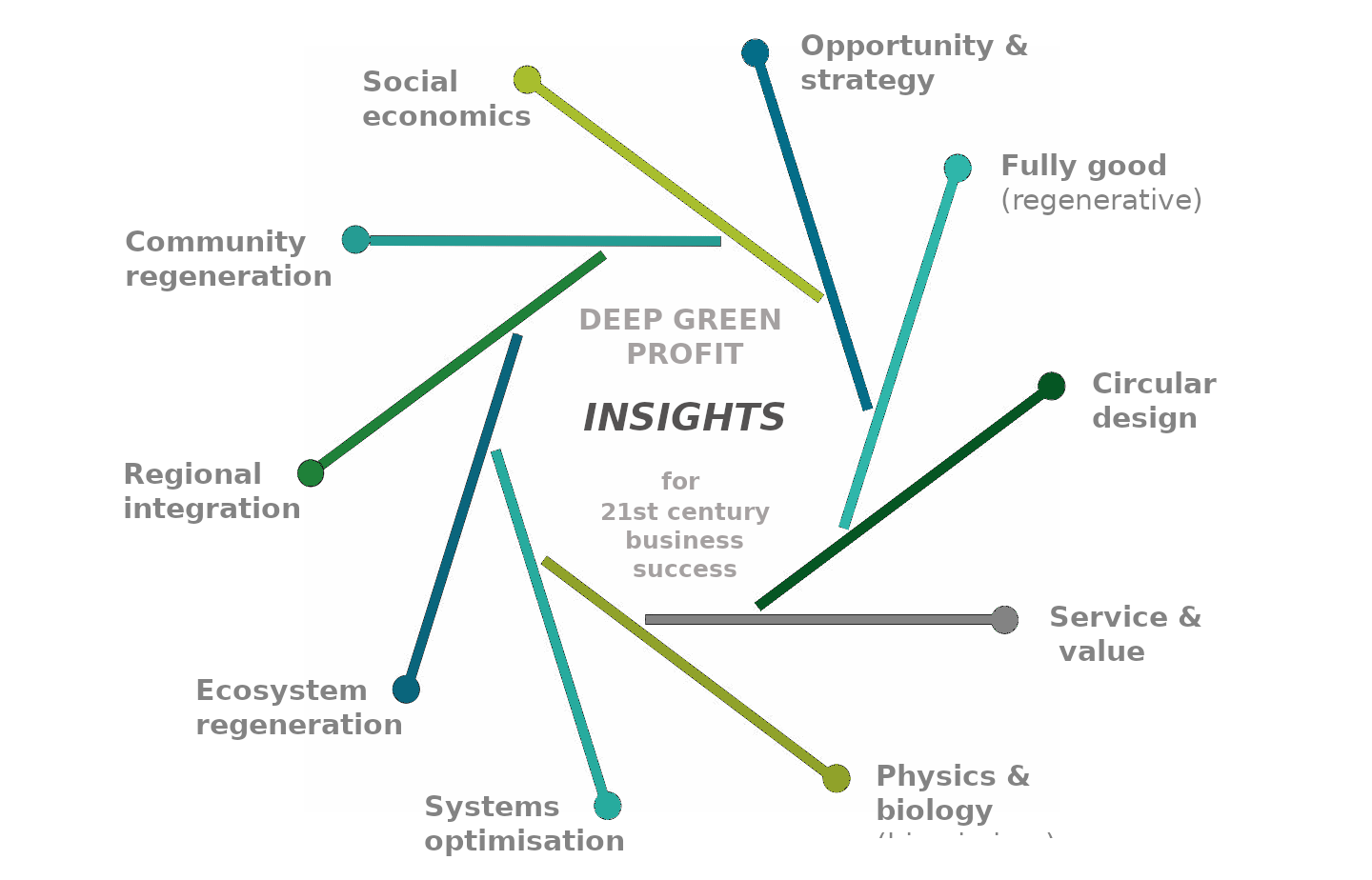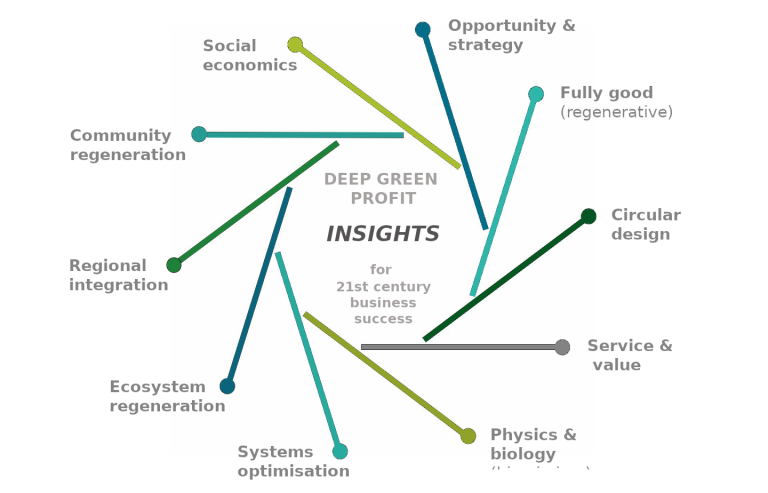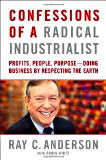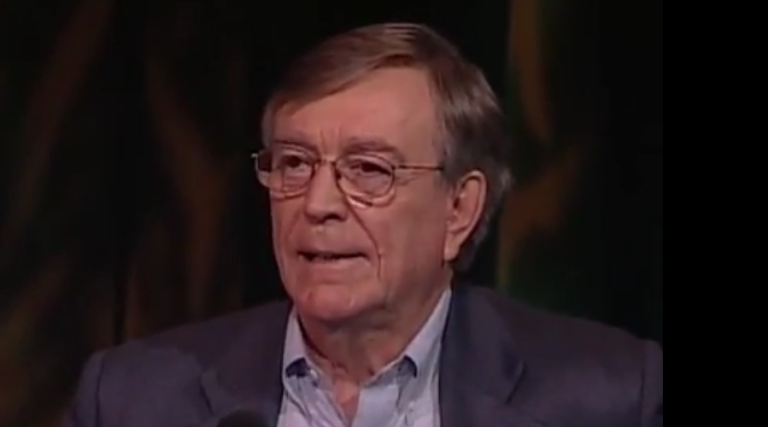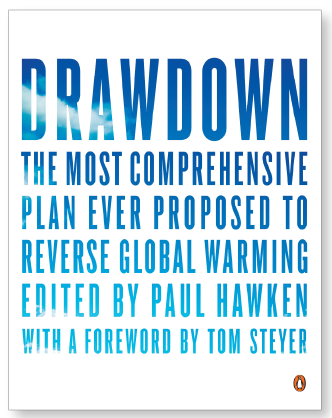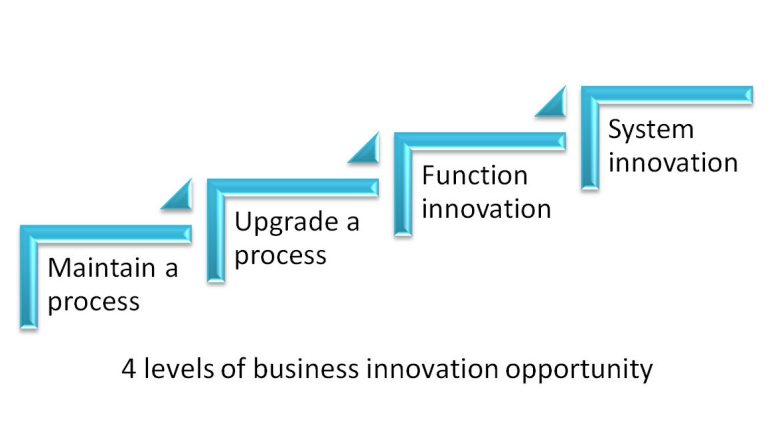What if waste isn’t normal and pollution isn’t manageable?
“Waste is a resource that’s in the wrong place”
We’ve taken “waste” for granted for millennia, assuming that it is an acceptable part of living, working and doing business.
We’ve also accepted toxins as being OK – within limits. It took us until the end of the 20th century to start taking lead out of fuels – not to mention house paint and makeup.
As the degenerative impact of waste and toxins from human systems becomes increasingly unacceptable, our normal human reaction is to “reduce”. Programs tend to be framed about “waste reduction” and “harm reduction” and “the goal of zero” – which sound SO obvious…
However, these 20th century approaches may NOT be the best way to uncover business opportunity and innovation. Why?
- Waste multiplies – so even 1% waste propagated down a 9-stage global supply chain stays significant – especially when you count the ancillary transport, energy and storage wastes.
- Toxins stay toxic – and we’ve come up with some amazingly long-life nasties in the last few centuries. We’re learning the hard way that there is NO “away”. Entropy (otherwise knowns as the second law of thermodynamics) applies, and materials generated by human industry will eventually disperse throughout nature (and in to us).
- Authorities are increasingly holding businesses and industries accountable for their waste, with extended producer responsibility regulation pushing back through the supply chain.
- Buying into “the goal of zero” risks running yourself into the wall of diminishing returns. The closer you get to zero, the harder (and more expensive) it gets to gain that last bit. And if you have to redesign eventually – why not start there?
- Reduction programs still assume that we have a “license to do harm” and that “less bad is a good start”. They don’t necessarily change the design mindset or inspire creativity.
- “Less bad” isn’t a powerful innovation driver – because the human brain doesn’t process negatives well. Essentially, it means that you’re still driving towards a cliff – just slowing down a bit.
What does stimulate innovation, engagement and bottom line benefits?
A nice Big, Hairy, Audacious Goal (BHAG).
Make things “all good” from the start
The engineers and designers and innovators of the world are increasingly turning on to “do more good”. It’s resulted in a wealth of new design approaches, from Cradle to Cradle Product Innovation to Biomimicry. (And a new business strategy or design principle – implemented strategically and consistently over time – delivers bottom line benefits.)
We’re gonna make a world less less unsafe, less unhealthy, less unjust, less polluted air less polluted soil, water and power, and economically driven How we doing? Is this it? Get up in the morning go get it done?…
[What about] a delightfully diverse, safe, healthy, and just world with clean air, soil, water and power – economically, equitably, ecologically, and elegantly enjoyed”
William McDonough, Design as Optimism
There is no “AWAY”!!!
It’s as though we’ve been operating on “infinite thinking” for the past few thousand years – an unspoken, un-inspected and increasingly flawed assumption.
We treat the ecosystems we inhabit as though they have:
- Endless resources for us to extract “raw materials”; AND
- Endless waste processing capacity, no matter what we dump; AND
- Endless capacity to absorb and purify toxins.
It turns out that there is no permanent, safe dumping ground for our waste – particularly not the complex toxic hybrids generated by industrialised processing. What might have worked for Henry Ford when the global population was under 2 billion is not fit-for-purpose in a world where the global population is rapidly heading for 8 billion.
This is practical physics, not idealism.
The Second Law of Thermodynamics tells us that “Matter and energy tend to disperse spontaneously”. Translated, this means “what goes around comes around” – including the poisons and contaminants used by traditional, extractive industrial models.
It’s the design thinking that’s stuck
Until recently, we haven’t even tried to design products for reuse and remanufacture; we haven’t designed supply chains to be closed loop systems that re-process products at end of life; we haven’t designed materials for safety and re-usability; we haven’t designed systems to recover products and reuse materials.
Waste percentages are costed into manufacturing processes – and mostly its disposal costs are lumped into “overheads” (which hides the true cost of production). Safety equipment, training and Hazardous Materials storage costs are also often disconnected from the “cost” of the products that use them.
A change to smarter thinking
A new design thinking is emerging – with approaches like Cradle to Cradle Product Innovation, Biomimicry and The Circular Economy. And what’s being uncovered isn’t “cost” – it’s trillions of dollars in business opportunity and innovation.
It turns out that when you get strategic and make things cleaner, smarter, more reusable and less wasteful THEN you make more money.
Upholstery to mulch
In an early Cradle to Cradle example a partnership was created between Designtex, William McDonough, Michael Braungart, and the Swiss textile mill Rohner. They set out to develop an upholstery fabric with remnants that would not be hazardous waste that incurred expensive disposal fees.
Braungart analyzed more than 8,000 chemical formulations commonly used in textile production, and found just 38 that were deemed safe for human and environmental health. These were the only dyes and process chemicals allowed to be used in the production of Climatex upholstery. (And turned out to be all they actually needed.)
Optimizing this chemistry changed the mill’s water release so much that it became cleaner than the incoming water. With fewer raw materials and no hazardous chemicals in the factory, storage and compliance costs substantially reduced. By producing fabrics that decomposed safely, the mill could save fabric scraps and turned them into felt, avoiding costly disposal fees. Local strawberry farmers used this felt as ground cover for their crops.
Take a Natural Step – new guidelines for rethinking industry
The Natural Step started when Swedish cancer scientist Dr Karl-Henrik Robèrt got tired of just treating avoidable diseases. In 1989 he wrote a paper describing the system conditions for sustainability, given the known laws of physics and natural systems.
In a sustainable society, nature is not subject to systematically increasing…
- …concentrations of substances from the earth’s crust (such as fossil CO2, heavy metals and minerals)
- …concentrations of substances produced by society (such as antibiotics and endocrine disruptors)
- …degradation by physical means (such as deforestation and draining of groundwater tables).
- And in that society there are no structural obstacles to people’s health, influence, competence, impartiality and meaning. The Natural Step
With this new thinking, materials are no longer anonymous and neutral – they’re either nutrients or they’re toxins. Nutrients can be either:
- TECHNICAL nutrients that can be safely and economically upcycled to maintain their value; OR
- BIOLOGICAL nutrients that can be safely composted.
So where you’ve traditionally accepted waste as a given, you could well be missing an innovation opportunity.
Industrial Era thinking is hiding opportunities and risks
In factories, standard manufacturing waste is calculated and just assumed. Waste disposal costs aren’t allocated back to products, instead they’re mostly collected into a bucket called “Overheads”.
Toxic chemicals are allowed and controlled (while the administration and handling costs they create also become “Overheads”). And with end-of-life product liability still in its infancy, what happens to your product after it leaves your warehouse has nothing to do with your business (for now).
Until recent years, waste just wasn’t seen as a potential value-stream – just a standard cost of “how we do business”. Excess waste is frowned on – but waste itself is expected and accepted in product design, system design, cost accounting and service design. Hazardous materials are still acceptable, and a whole range of expensive overheads have developed to “manage” them.
Unspoken assumptions limit our thinking
The assumption that “we can always dig up more” has been an unspoken fundamental principle of the production of products and services. The fundamental design of the supply chains that deliver everything from food and cars to energy and sewage has been built on the model of a 1-way system.
Not only is this massively destructive at a planetary level, it’s also massively expensive. The pioneers developing new business models are also finding innovation and cost savings when they bring the indirect costs of 20th century product design into the business equation.
Valuable, beneficial nutrients; finite resources; infinite ingenuity
What happens when we update our assumptions? What new opportunities open up when we start to operate within the current reality of our closed, finite ecosystems, where our only true input is solar energy and the occasional meteor? How can we use our own ingenuity and nature’s massive library of design know-how?
How can we do design differently – taking a global, whole-of-life perspective in supply chain design, product development, business costing and service delivery? So let’s play “what if”. What if unusable waste:
- Was never created?
- Couldn’t be toxic?
- Was always designed to be valuable as “food” for another process?
What if we only designed products that:
- Create valuable by-products that return an income to our business?
- Are totally safe to make, totally safe to use and totally safe to dispose of? So that we can save on OHS and EHS?
- Are endlessly recyclable into more quality product?
Explored for opportunity, “wastes” can become valuable by-products which deliver business, ecosystem and community value.
How big are the hidden costs?
Back in 1994 – at the start of their sustainability adventure – carpet company Interface took on the Kaizen definition of waste as “anything that doesn’t add value to our customers”. When they added up the costs of everything from imperfect carpet and wrong shipments to clerical errors, they identified $70 million in waste – which was making a fair-sized a hole in their $700 million sales revenue. (Source: Business Lessons from a Radical Industrialist)
If you can’t find a value in your by-products, then step back and check whether you’re observing the systems you’re part of accurately.
If you still can’t find a value in your by-products – if you have to pay for someone to take them away – then what you have is a poison – not a waste. Which makes it likely that the best, most profitable solution is to design it out of existence.
This is the 21st century. It’s delivered everything from printable flexible solar cells to dirt-repelling windows. The chances of there being a valuable use for your waste – or an alternative to your toxins – are actually pretty high.
What does this look like?
In the Cradle to Cradle project (above) that redesigned a textile factory for totally beneficial products and processes, the factory actually became a water filter. The output water was SO clean that at first the authorities testing the water thought their equipment was broken.
Carpet tile manufacturer Interface has been a leader in this global shift – here are just two examples:
- PVC recycling
- VOC glues for carpet installation
PVC is widely acknowledged as toxic – if disposed of incorrectly. New PVC is made from non-renewable fossil oil. Interface closely examined the use of this ingredient and decided that their best option was to follow The Natural Step’s principle of “change a wasteful use of metals and minerals from the earth’s crust into a cyclic use, where materials can be re-used indefinitely”. So they chose to use 100% recycled PVC and developed the technology to make it happen.
Interface also put their R&D teams on to the problem of Volatile Organic Compounds – the glues traditionally used to hold down carpet tiles. Smart engineers designed a whole new way of fastening the carpet tile together – using mechanical clips rather than glue. So they designed out harmful VOCs completely – and created a new selling point for their carpet tiles as well as a cheaper, smarter installation system.
It’s not just big businesses who benefit from turning waste into valuable materials. Western Australian entrepreneur Darren Lomman started an upcycling program to collect PET bottles and reprocess them into feedstock for 3D printing in local schools.
Blue Economy entrepreneurs are turning coffee grounds into feedstock for growing high-value exotic mushrooms. Others are using smart technology to create a water-free “stone” paper from PET plastics combined with stone dust from mine tailings.
Blue Economy innovators Ecovative developed compostable packaging grown from species of fungi. In India, smart entrepreneurs are upcyling religious flowers in to incense and soap (to be used for religious purposes).
On a whole different scale, renewable energy entrepreneurs are recycling a disused gold mine to generate renewable energy to the grid. Excess solar energy produced during the day is used to pump water to holding dams at the top of a hill. At night, electricity demand is met by releasing the water to power hydro generation.
Some questions to challenge your existing thinking
- What’s in your dumpster that you don’t know the value of?
- What toxins are embedded in your process that you could replace?
- What are the wastes in your local area that are hidden resource treasures waiting to be turned into value?
Stories, sources and resources
A great book explaining the design thinking behind this approach is Cradle to Cradle by Bill McDounough and Walter Braungart. They went on to found the Cradle to Cradle Product Innovation Institute.
Examples of how this was applied by Interface are included in the practical, readable book Business Lessons from a Radical Industrialist by Ray Anderson and Robin White.
The Ellen Macarthur Foundation for the Circular Economy has a wealth of resources available.

